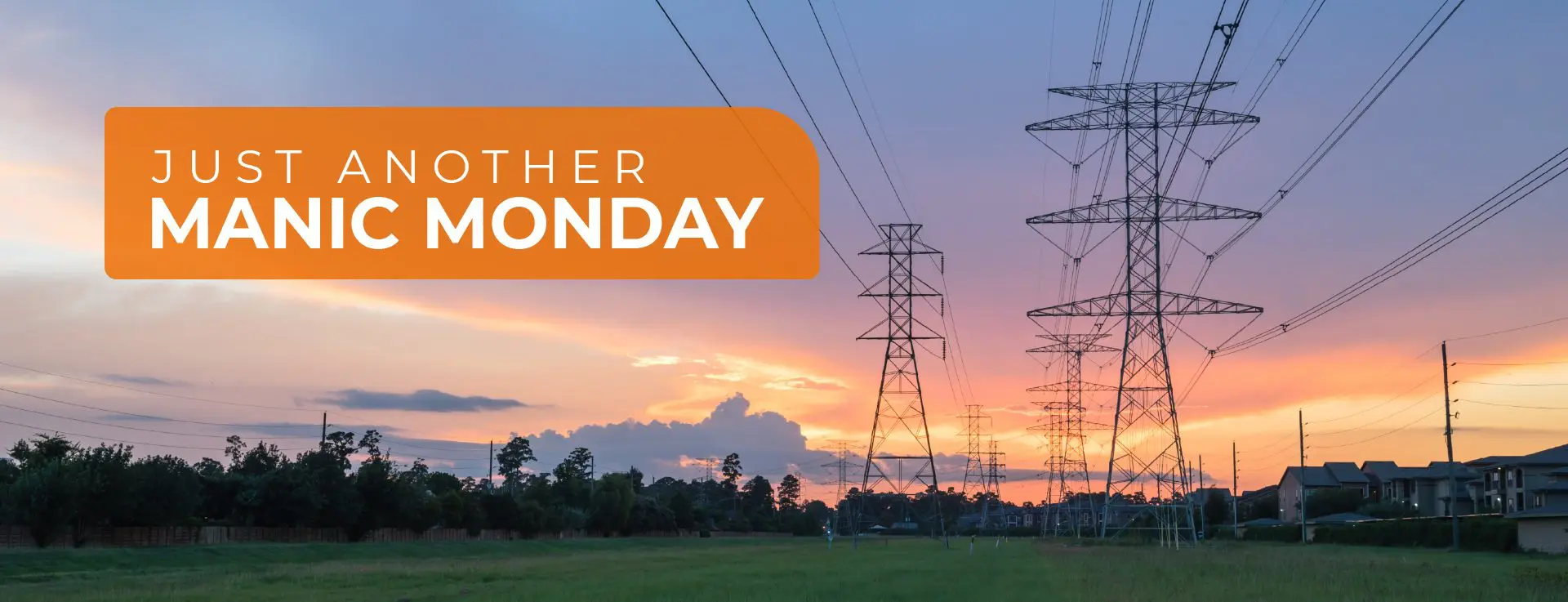
Just another manic Monday
Monday 12 of June 2023 was an eventful one for the all-island electricity grid. This article provides some insights from VIOTAS as to what occurred.
Frequency Event
In the early hours of Monday 12 June, demand was typically low for a summer’s night falling to approximately 3,200 MW. At the same time, wind generation was very low at approximately 100 MW, leading to the Moyle Interconnector and the East-West Interconnector (EWIC) both heavily importing at close to their maximum capacities (442 MW & 530 MW respectively)(1) . In addition, as is typical over the summer months where many conventional power stations are taken offline for planned maintenance, there were 2.2 GW of generator outages (2).
At 3:29am, the Moyle Interconnector unexpectedly went offline or suddenly “tripped”. Just before the trip, Moyle was importing 442 MW – roughly enough to power nearly 285,000 houses and supplying just under 15% of the all-island system demand at the time. The trip caused the frequency to fall to a nadir of 49.69 Hz as recorded by VIOTAS’ high-speed systems. In response to the fall in frequency, many generators, battery storage systems and industrial customers participating as part of a Demand Side Unit (DSU) automatically responded to replace the MW lost by the Moyle Interconnector. This included many industrial sites within the VIOTAS portfolio, which responded by shedding loads within as quickly as 150ms to help arrest the frequency fall and restore it to the nominal system frequency of 50 Hz.

Morning Load Rise
While the unexpected loss of MW (caused by a unit tripping) can cause headaches for the EirGrid National Control Centre at any time of day or any day of the year, this is particularly unwelcome just before the Monday morning load rise. The reason for this is many conventional generators would have been offline over the weekend due to the reduced system demand and EirGrid would typically call these units back online as the load ramps up quite aggressively most Monday mornings as factories & offices etc around the country return to operation following the weekend break.

As a result of the challenging conditions on the power system during the Monday morning demand pickup, despite the Moyle Interconnector being back in operation, by 7:30am 121 MW of DSU’s were dispatched to assist EirGrid to meet the morning load rise, including many commercial and industrial sites within the VIOTAS portfolio. This type of flexibility, with fast response times, is of high value to the power system in exactly these types of situations.
Amber Alert
Before midday, Met Eireann issued a thunderstorm warning for the majority of counties in Ireland. Thunderstorms are particularly unwelcome for the Grid Operators in EirGrid’s National Control Centre as they increase the likelihood of transmission equipment faults which could cause power supply interruptions. At 12:41pm EirGrid issued a System (Amber) Alert to warn market participants that conditions on the power system had deteriorated and system margins were tight due to very low wind, low solar and increased forced outages across the power system. Transmission connected customers within the VIOTAS portfolio who participate in EirGrid’s Mandatory Demand Curtailment programme prepared themselves to take action to reduce demand should they be called upon to do so by EirGrid. This is another example of large energy users assisting the safe and secure operation of the power system, in partnership with VIOTAS.
Evening Peak
While the evening peak is less pronounced in summer months compared to winter months, EirGrid still needed to dispatch 179 MW of DSUs to assist in meeting the evening peak. While such conditions are thankfully exceedingly rare, for some VIOTAS customers this represented the second time in a single day they were called upon to provide critical support to the power system, and play their part in keeping the lights on. Thankfully, no other unforeseen event occurred and EirGrid ended the System (Amber) Alert at 6:34pm.
Conclusion
While managing a system with high levels of renewable generation is an impressive feat for any power system, this is especially true for a relatively isolated power system such as Ireland. It could be argued that managing a power system with high levels of renewable generation is the easy part but managing that same system at times of low renewable generation and still ensuring the lights stay on regardless of what unforeseen events transpire, is what makes Ireland’s power system truly world leading.
VIOTAS would like to thank our customers who continue to play a vital role in providing the highly valuable flexibility to the power system that enables it to accommodate increasing levels of renewable generation. VIOTAS would also like to extend our gratitude to EirGrid, particularly the staff of the National Control Centre, who seamlessly manage days like this so most of us are unaware and unimpacted. A series of unfortunate events for some, was just another manic Monday for the Irish power system.
Aside
Coincidentally, around the time the Moyle Interconnector tripped causing the frequency event in Ireland, there was a similar event in Australia. One of the large coal power stations in Queensland tripped and caused the frequency to fall. Similar to Ireland, VIOTAS had sites in Australia responding in less than 1 second to arrest the frequency drop and restore it to its nominal range. While the two events were unrelated, Control Centre staff at VIOTAS HQ in Limerick were busy managing both events in opposite sides of the world from the one room. This is a great example of the positive impact demand response can have to provide much needed flexibility and enable power systems all over the world to transition away from fossil fuels and accommodate more renewable generation.
(1) Interconnectors are electricity links which facilitate the transfer of power. Moyle Interconnector runs from Antrim, Northern Ireland to Ayrshire, Scotland while EWIC runs from Meath, Ireland to Shotton, Wales.
(2) 692 MW of Scheduled Outages and 1,569 MW of Forced Outages. https://www.eirgridgroup.com/site-files/library/EirGrid/Outage-Week-24(2023)-39(2023).xlsx



